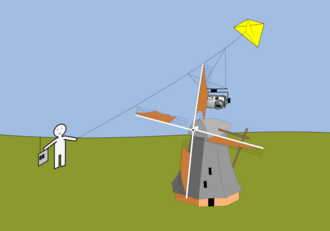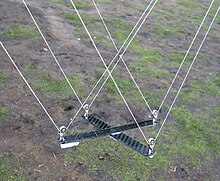Can You Use a Drone for Commercial Aerial Photography

Kite aerial photography (KAP) is a type of photography. A photographic camera is lifted using a kite and is triggered either remotely or automatically to accept aerial photographs. The photographic camera rigs can range from the extremely simple, consisting of a trigger mechanism with a dispensable camera, to complex apparatus using radio command and digital cameras. On some occasions it can be a good alternative to other forms of aerial photography.
Photographic camera rig and stabilisation [edit]

The photographic camera can be fastened directly to the kite but is usually secured to an adjustable rig suspended from the kite line at a distance from the kite. This distance reduces excessive move being transmitted from the kite to the camera and allows the kite to be flown into higher, stable air before the camera is attached. If possible, the photographic camera is set to a high shutter speed to reduce motion blur. Cameras using internal paradigm stabilization features can increase the number of sharp photos. In society to take photographs that are oriented correctly with the horizon, a suspension method is used to allow the rig to automatically level itself under the kite line.
Pendulum break [edit]

This simple levelling method involves suspending the camera from a rigid length of cloth below the kite line. Gravity naturally keeps the rig level, irrespective of the bending of the kite line. The pendulum will oscillate due to motion from the kite line and wind pressure level, simply the camera will remain steadier and more level than without a pendulum.
Picavet suspension [edit]
A Picavet interruption, named after its French inventor, Pierre Picavet, consists of a rigid cross suspended below the kite line from two points. A single line is threaded several times between the points of the cross and the points of attachment to the kite line and the rig is fastened to the cross. The Picavet line runs through eye hooks or modest pulleys and then that the weight of the rig causes it to settle naturally into a level position. The dimensions and shape of the Picavet have been adjusted many times in attempts to increment stability or to improve portability.
Shutter release and camera positioning [edit]
The shutter of the camera can be released in several ways, depending on the type of photographic camera and complexity of the rig electronics, if used. Shutter release mechanisms include using a radio controlled servo to press the shutter release push button, using an infrared point or wired connectedness to instruct the camera to release the shutter, or by using the camera'south inbuilt intervalometer. Ideally the camera is immune to reach its final distance earlier the shutter is released to avoid taking photos during launch.
Fixing the photographic camera straight to the kite or line makes changes to positioning awkward. If the photographic camera is fitted within a frame, this 'rig' tin can be designed to rotate horizontally and vertically and to change the picture format from portrait to mural by rotating the camera. Adjustments to these angles can be made by manually setting the rig on the ground or past adjusting the rig while information technology is airborne using a remote control or an automated controller in the rig. Normally a radio command system, equally used for model shipping is used. The servos in these systems are readily adaptable to arrange rig positioning. Several automated controllers have been developed that tin can take a photo, move the camera by a set angle, take the next photo and and so on.
Kites [edit]

The virtually of import aspect of any kite used to lift a camera is stability. By and large, single lined kites are used as they allow very long line lengths and need less intervention from the flyer than steerable designs. Almost any stable kite pattern can be used to lift lightweight camera rigs (upwards to approx 500g/1 lb). As weight increases, specific designs are called for their additional flying characteristics, such every bit line pull, wind speed, flying angle and ease of launch. Widely used designs are parafoil, rokkaku, delta (including variations such every bit delta conyne) and the new lighter-than-air helikite blueprint. Of these, the parafoil is most pop as it generates a strong pull for its size, and can exist easily stored in a small-scale space due to its sparless construction. Sparred kites such equally the rokkaku or delta tend to fly at a higher angle than parafoils, which is of benefit when the space betwixt the launch site and photographic subject is limited. A higher flight angle permits the kite to lift more weight, every bit more than of the generated forcefulness is acting vertically. Helikites allow reliable KAP in difficult atmospheric condition, thus opening upward the use of KAP for professional person photography.
History [edit]



The beginning kite aerial photographs were taken by British meteorologist Douglas Archibald in 1887[i] and by Arthur Batut in Labruguière (France) in 1888.[2] [three]
Manned kite flight and aerial photography was avant-garde also by French Marcel Maillot, British Robert Baden-Powell, Americans Charles Lamson and William Abner Eddy, Australian Lawrence Hargrave (inventor of box kite in 1893 and kite train in 1884) and French Captain Saconney.[4]
A famous aerial photo of San Francisco after the 1906 convulsion was taken by an early on pioneer in KAP, George Lawrence, using a big panoramic camera and stabilizing rig he designed.[v]
KAP today [edit]

Kite aeriform thermogram of Cairnpapple Hill Cairn, West Lothian, with the kite flyers shown standing at the foot of the cairn
With the advent of the Internet, lite and affordable digital cameras, radio command and microelectronics, kite aerial photography has go increasingly popular. In latter years, kits take go available that enable a beginner to rapidly get together a functional KAP rig and start taking aerial pictures in the visible part of the spectrum and, with more experience, in the ultra-violet, near and thermal infra-ruddy[6] parts of the spectrum too.
Practical and commercial use of KAP is limited by the unpredictability of the weather (notably air current, lord's day and rain) and the fact that not every site is suitable to flying a kite. Launching a kite about buildings or downwind of trees can be problematic, due to heavy turbulence. The main applications today are amateur photography, art and, especially, archæology as described on the webpages of the West Lothian Archaeological Trust. Another growing application is its use for community mapping and environmental monitoring by the widespread Public Laboratory for Open Technology and Science.[7] Enquiry scientists are using kite aerial photography for monitoring bird species and also for studies in the geographical and geological sciences, including photogrammetry. Increasingly, kites are being employed where the apply of a small unmanned aerial vehicle (SUAV, usually known equally a drone) is either impractical, or encounters legal or other constraints. Attempts to commercialize KAP have so far been largely unsuccessful.
See also [edit]
- Balloon Experiments with Apprentice Radio
- Panoramic photography
- Aeriform archaeology

Kite aeriform photo of Black Castle, Scotland, taken flying the kite from the end of the jetty.

References [edit]
- ^ Archibald, Douglas (1897). "The Story of the Earth'south Temper". p. 174. Retrieved 2011-04-16.
- ^ Benton, Cris (June 25, 2010). "The First Kite Photographs". arch.ced.berkeley.edu. Archived from the original on June ix, 2011. Retrieved 2011-04-sixteen .
- ^ "Arthur Batut Museum" (in French). Retrieved 2008-01-08 .
- ^ See kite timeline 1800-1900 on a website dedicated to kites history.
- ^ Baker, Simon. "The Lawrence Captive Balloon over San Francisco". Retrieved 2008-01-08 .
- ^ "Photographic Techniques". Retrieved 2012-12-02 .
- ^ "Public Laboratory for Open Technology and Science".
External links [edit]
- Scottish National Aerial Photography Scheme (SNAPS), West Lothian Archaeological Trust (UK)
- Kite Aerial Photography Data
- Kite Aerial Photography Forum
- KAP jargon explained
- Sample Kite Aerial Photographs
- Photographs of Kite Aerial Photography Rigs
- HD-Kite-Panoramic Photos
- Sample Kite Aeriform Photography Images and data
- Kite Aerial Photographers - Archeology
- An in-depth article on Medium well-nigh kite aerial photography
Comments
Post a Comment